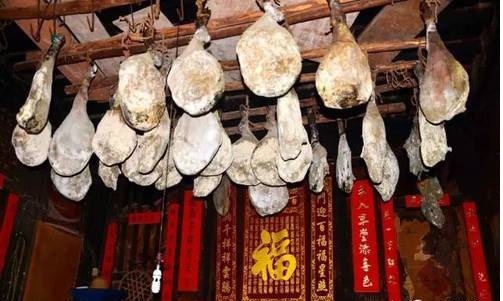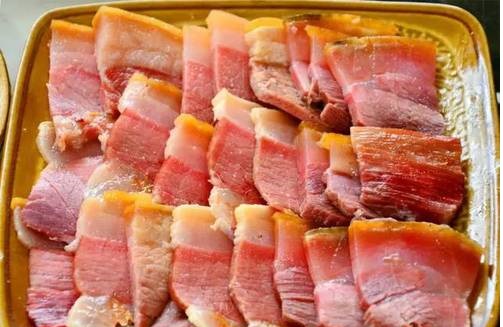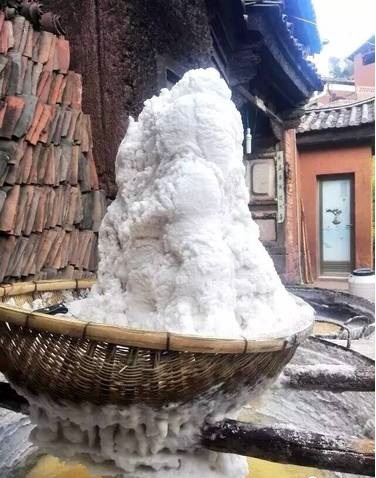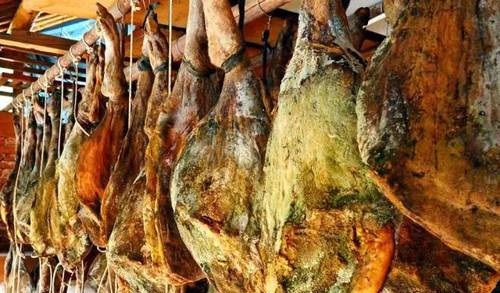 alt="Market Days in Menglian and Townships, Puer"
/>
alt="Market Days in Menglian and Townships, Puer"
/>
Nuodeng Ham in Dali, the Intangible Cultural Heritage
Nuodeng Ham (诺邓火腿) is one of the Intangible Cultural Heritage in Yunnan, famous for its making process, falvor and high quality.

History:
The history of Nuodeng Ham began in Tang Dynasty and became prosperous in Song Dynasty. It was also called Salt-Mud Ham(盐泥火腿), due to its special making method. It is said that The King of Nanzhao(南诏) once traveled to Nuodeng(诺邓), found that Nuodeng Ham was pickled in salt and mud, he was surprised a lot. Then he was impressed by its ruddy colour and amazing taste, he praised it endlessly. So, Nuodeng Ham became a royal tribute at that time.
Location:
Nuodeng Ham comes from Yunlong County, Dali(大理州云龙县), which known as the Healthy Mountain City(健康山城). The vast mountain forest pasture in this county provides excellent conditions for the growth of Nuodeng Black Pig(诺邓黑猪). Newborn piglets are kept in the field, mainly fed on wild plants, and then fattened by plants such as corn and soybean in captivity. It takes more than one year to fatten them. These pig’s meat is tastes better, which provides the best meat source for Nuodeng Ham.
Making Method:
The winter before of Spring Festival is the best time to make Nuodeng Ham. When miking hams in winter every year, local people cool the fresh pig legs for 12-24 hours, then remove the excess flesh from the legs, then find the blood vessels on the legs and squeeze out the blood so as to ensure that they will not deteriorate. Then use Nuodeng grain wine to sprinkle evenly on the legs of pig. Then evenly sprinkle salt on the legs while rub them so that they can absorb the salt. Finally, evenly sprinkle a layer of salt on the pig legs again, gently press the pig legs. Then put the legs into a wooden cylinder, cover them with a lid. Keep the legs in side for about 15 to 20 days. Then take them out.
Here comes the key process of making a Nordeng Ham, evenly spread a layer of stove ash and the mixture of Nuodeng salt and mud on the ham. It is said that this kind of mud has the functions of keeping fresh, increasing fragrance and preventing insects. Then suspended the legs in a cool and ventilated place with a rope.Usually a ham can be stored for at least one year, at most more than three or five years. What’s more, The longer the ham stored, the better the color, aroma and taste. Such processed made the real reputation of Nordeng Ham.

Tips:
1. The Salt
The salt used in pickling Nordeng Ham is the best salt produced by local salt wells. Don’t underestimate this self-made salt. Nordeng Salt is the highest quality salt in Yunlong County. It is said that the common salt can only soak six pieces of meat, while the Nuodeng salt can soak more than seven pieces of meat. The salt contains potassium, magnesium and other trace elements, which made the color and aroma of the ham better.

2. The Green Mold on Nuodeng Ham
Most of the hams stored for more than two years, were covered with green mold. Local people called this Hanging Green Clothes(挂绿衣). Some people mistook this for bad quality, in fact, only the ham with “green clothes” tasted the best. Stripped of its green coat, the ham looks like amber, the fat is creamy white, and the meat is peach and bright red. Rich flavor, tender meat, salty degree is appropriate, the ham is the best in color and aroma.

Chinese Version: http://ylx.gov.cn/view/front.article.articleView/9158/32/805.html
Translated by Emily -Wang/王海玲

 7 Days GolfingTour
7 Days GolfingTour
 8 Days Group Tour
8 Days Group Tour
 8 Days Yunnan Tour
8 Days Yunnan Tour
 7 Days Shangri La Hiking
7 Days Shangri La Hiking
 11 Days Yunnan Tour
11 Days Yunnan Tour
 6 Days Yuanyang Terraces
6 Days Yuanyang Terraces
 11 Days Yunnan Tour
11 Days Yunnan Tour
 8 Days South Yunnan
8 Days South Yunnan
 7 Days Tea Tour
7 Days Tea Tour
 8 Days Muslim Tour
8 Days Muslim Tour
 12 Days Self-Driving
12 Days Self-Driving
 4 Days Haba Climbing
4 Days Haba Climbing
 Tiger Leaping Gorge
Tiger Leaping Gorge
 Stone Forest
Stone Forest
 Yunnan-Tibet
Yunnan-Tibet
 Hani Rice Terraces
Hani Rice Terraces
 Kunming
Kunming
 Lijiang
Lijiang
 Shangri-la
Shangri-la
 Dali
Dali
 XishuangBanna
XishuangBanna
 Honghe
Honghe
 Kunming
Kunming
 Lijiang
Lijiang
 Shangri-la
Shangri-la
 Yuanyang Rice Terraces
Yuanyang Rice Terraces
 Nujiang
Nujiang
 XishuangBanna
XishuangBanna
 Spring City Golf
Spring City Golf
 Snow Mountain Golf
Snow Mountain Golf
 Stone Mountain Golf
Stone Mountain Golf













 What Our Customers Say?
What Our Customers Say?
